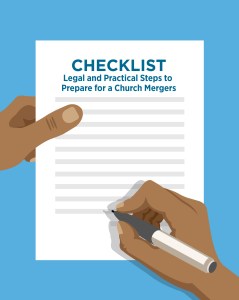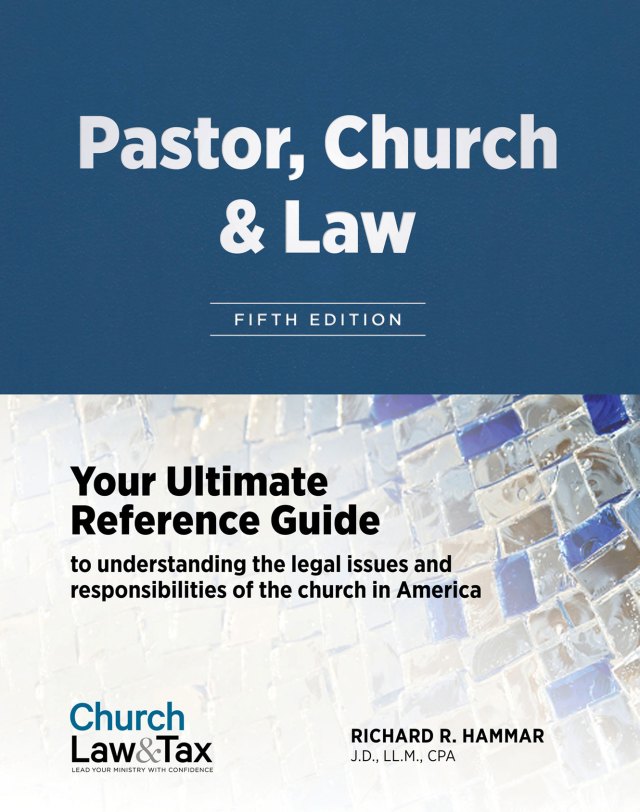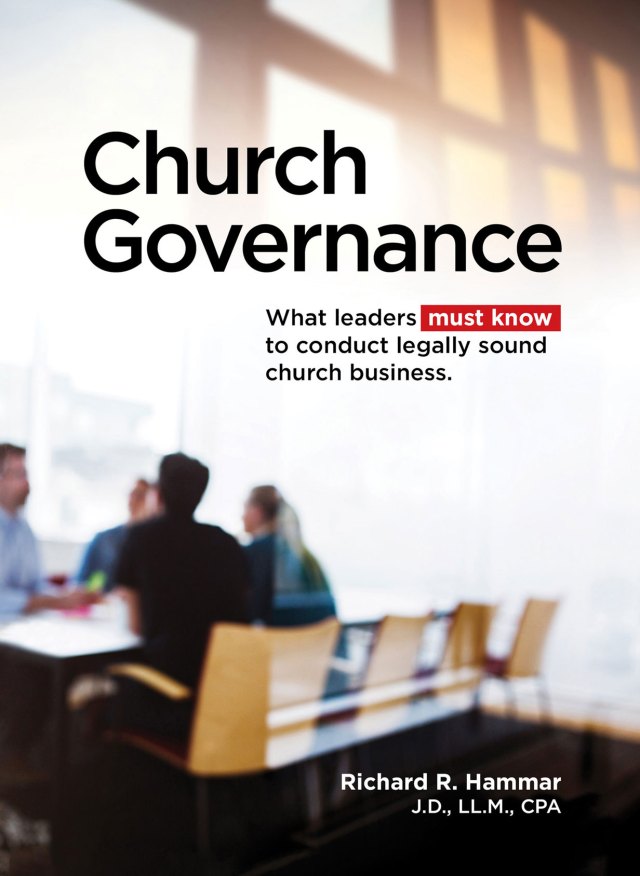In the first installment of this four-part series, I shared that church mergers are on the rise. As an attorney whose practice focuses solely on the representation of churches, I see churches opt for this useful legal strategy as a viable means to sustain a stymied church or to further grow a healthy church.
Mergers will be an especially important consideration in a post-COVID-19 world. As David Kinnaman, the president of Barna Group, said regarding the 2020 state of the church, “[t]he challenges of leading the people of God are formidable and still the opportunities for community transformation and personal flourishing are surprisingly bright.” I believe that church mergers are such a bright spot. To be successful, however, the decision to merge must begin with earnest prayer and deep spiritual contemplation. But it cannot stop there. The most successful mergers have a healthy recognition of the legal, accounting, property, and other temporal—but important—considerations.
While the legal nuts and bolts of a merger are similar—whether combining two businesses or two (or more) churches—the unique missions of the churches, the special relationships between the people in those churches, and the churches’ tax-exempt statuses make the process distinct from the run-of-the-mill corporate merger.
What is a church merger?
A church merger legally combines two or more churches into one remaining entity.
As a general matter, and as I explained in Part 1 of this series, there are three ways a church merger can be done:
- Church A merges into Church B (the surviving entity);
- Church A dissolves, leaving its assets to Church B after all of Church A’s liabilities are disposed; or
- Both Church A and Church B dissolve and form a new Church C.
Deciding which merger strategy to use is made on a case-by-case basis and can be best determined as a result of due diligence. Due diligence is a systematic process involving detailed reviews of the legal, accounting, and other relevant information from each of the merging churches.
A high level of transparency is needed since the decision to merge is likely one of the most significant decisions that church leaders will make. While it can seem easier to bypass due diligence in favor of a “handshake,” to do so would be to the potential peril of all parties. The process of due diligence can take many months to complete and encompasses the areas detailed in this article and the remaining two articles in this series.
Read more about how to approach due diligence in Part 1.
What documents and information should be gathered upfront?
For the document-gathering process—utilizing the provided checklist—prioritize gathering the following.
Articles of incorporation and all amendments for the existing churches
The articles of incorporation is the document that must be filed with the secretary of state in order to form the legal entity. It must be filed in the jurisdiction where the church is located, or as may be the case for multisite churches, where the central organization is located. All states and the District of Columbia have their own requirements as to what must be included in articles of incorporation.
Generally speaking, each state requires:
- the name of the church;
- the principal address of the church (many states require this to be a physical address, not a post office box);
- the statement outlining the purpose for the creation of the new legal entity;
- the names of trustees, the initial number of trustees, and details of how new trustees will be elected;
- the name and street address of the church’s registered agent. The registered agent (known in some states as resident agent) is the individual or corporation designated by the church to receive any official notice that may need to be served on the church. The registered agent who receives such information on the church’s behalf ensures the proper parties are notified and that any legal matters are addressed; and
- certain statements a church may have included for state and federal tax-exempt purposes regarding the use of funds, restricted activities, and the distribution of assets upon dissolution.
Articles of Amendment
Any articles of amendment filed with the state must be gathered as well. Articles of amendment (which serve to amend or otherwise restate the articles of incorporation) may be filed when a church changes its name, broadens or otherwise alters its purpose, or amends other salient details of its operations.
The formation documents are particularly important during the merger process because each party should know the legal status of the other and be certain that each side is in good standing with the state where it was formed. As a general matter, if a church is not in good standing, any merger documents will be rejected for filing until the issue or issues get resolved.
Lastly, it is important to use the church’s legal name in all merger documents, which should be confirmed by reviewing the official corporate records.
Note. Some churches are not incorporated. Some believe incorporating may “entangle” a church in government affairs, create high costs to maintain, or cause administrative burdens for staff to make the annual or biannual report that most states require a legal entity to file.
As a general matter, incorporation wouldn’t entangle a church with the state any more than when it files a property deed, which also has to be done with the state government.
As to annual costs, filing fees generally run between $0 and $300 and most forms can be filed online without much trouble.
In any event, even if a church is unincorporated, it can certainly enter into a merger; however, the fact that a church is unincorporated may be one of the many considerations to weigh during due diligence.
Learn about the legal ramifications of unincorporated churches, and the personal liability they can pose to their members, in Church Law & Tax’s Legal Library.
Bylaws
Bylaws are the internal governing documents outlining how the board will operate, its term, and its process for elections, as well as the roles of officers, the qualifications of officers, and other salient details guiding internal operations.
Unlike the articles of incorporation, bylaws are generally not filed with the state. Because of this, it is particularly important that a church diligently keep its bylaws in a safe place, including a current paper copy. Reviewing the bylaws is of critical importance during the due diligence period. This document will confirm who has the authority to authorize the merger, and what governance process is required. For example, is a two-thirds vote of approval by the board required or a majority vote of the congregation? How much notice is required before a meeting on the merger question can be held?
Constitution
A church constitution outlines a church’s tenets of faith, including matters like baptism, the sacraments, marriage, and so on. In the context of a merger, the constitution can provide great insights into the compatibility of the churches in terms of religious beliefs.
Note. For some churches, this document is called the articles of faith. Other churches combine the constitution and bylaws. For myriad reasons, I never recommend combining the bylaws and constitution. This is primarily because the bylaws may be examined by a court of law when considering whether certain operations have been properly followed, while the constitution is ecclesiastical in nature—and every effort should be made to keep such matters well beyond the reach of the courts.
All policies and procedures documents
Policies and procedures in the context of church operations includes employment policies, child protection policies, sexual harassment policies, social media policies, expense reimbursement policies, and so on. These types of policies form the backbone of each church’s operations and, if they exist in good form, can save a lot of time and effort in avoiding the proverbial recreating of the wheel during the merger.
EIN letter from the IRS
An employer identification number (EIN), also known as a federal tax identification number, is assigned by the Internal Revenue Service (IRS) when a Form SS-4 is completed and submitted by an authorized individual on behalf of the church. Just like a Social Security number identifies an individual, an EIN identifies a church.
Usually, when the church opens a bank account, this document is requested by the bank to ensure that the funds are held for the benefit of the church. This number is also used to identify any payroll taxes that may be payable (which is generally the case when a church has employees), and the EIN is listed in any Form 1099s issued by the church to independent contractors (if it has any). Verifying each church’s correct EIN will be important as merger documents are prepared.
All relevant tax- and exemption-related records
Gather all tax- and exemption-related records, including IRS letters of determination, state sales tax certificates, and real property exemptions.
While churches are not required to file Form 1023 for recognition of exemption under Internal Revenue Code Section 501(c)(3), many churches do so in order to receive the official IRS letter of determination to plainly show donors the church’s exempt status.
Moreover, as state and local governments struggle with their fiscal bottom lines, they are increasingly raising the bar on churches and other nonprofits whose tax breaks are seen as taking away from their coffers.
In many (if not most) jurisdictions, local governments are requiring churches to provide their IRS letters of determination with applications for other tax exemptions, such as sales tax exemptions, property tax exemptions, and other local tax exemptions.
Note. In the process of gathering important documents during due diligence, be sure to pull and organize all exemption records, including the Form 1023 application for exemption (if one was filed by any of the churches involved with the potential merger). The IRS requires a church to keep on file its Form 1023 application as submitted. If your church can’t locate its letter of determination, you can complete and submit Form 4506-A to request a confirmation of your exempt status.
Copies of all property deeds and related records
Each church involved in the merger should gather a copy of deeds to all real property it owns. If your church doesn’t have its property deeds, a request for them usually can be made to the jurisdiction where the property is located.
Also compile any records related to any deeds of trusts, mortgages, or other related property records.
Other documents and information
- Governing board: Prepare a list, including titles, of all board members, officers, and their roles for each church. These individuals will likely need to make the final decision (or submit the decision to the congregation if it operates by a congregational model).
- Church staff: Prepare a list that includes titles, roles, responsibilities, years employed, and levels of training. Gather and review all related written employment agreements and independent contractor agreements. Be sure to confirm that workers are properly designated as employees or independent contractors.
- Ministries: Prepare a list that includes ministry leaders’ names, titles, years served, and the purpose and accomplishments of each ministry. Should the merger move forward, it will be important to know which ministries operate successfully and should continue as the churches combine.
- Ancillary ministries and integrated auxiliaries: For each separately incorporated ministry (such as a school, childcare center, and so on), complete due diligence as outlined in the provided checklist.
- Ministry employees and volunteers: Prepare a list of employees and volunteers working in the various ministries and ancillary ministries. Include names, titles, roles, wages, years employed, written agreements, and hours worked per week—even for those who are not paid.
- Assets: Create a list of assets that includes pertinent related details, such as market value, age, condition, repairs needed, deeds, titles, insurance policies, and service contracts. Also include any known grants, bequests, and promised gifts.
- Debts: Prepare a list of all debts owed, including their pay-off amounts. This list should be supported by the related loan documents. Remember to also include all service contracts not listed above.
Moving toward a successful merger
A successful merger can be a great way to extend the impact of two churches with similar missions by coming together under the strength of one name. Having gathered and reviewed the critical due diligence information as outlined above, I will next—in Part 3—review the critical decisions that church leaders will need to undertake as they consider the possibility of a church merger.
Also in this series:




